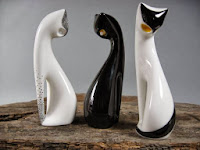CERAMIC DESIGNS
1950s
ceramics are instantly
 |
| CERAMIC DESIGNS |
 |
| CERAMIC DESIGNS |
The
pottery industry was quick to capitalise on these developments, and
the styles that were introduced set the tone for the next 20 years,
drawing on an eccentric and eclectic range of sources. There were
patterns incorporating atomic' styling - inspired by diagrams showing
electrons and neutrons - as well as Parisian street- scenes, circus
motifs, shooting stars, and even tableware decorated with
contemporary furniture designs.
The most notable producers of this new style
were Midwinter, Beswick, and Ridgway, but there are numerous others.
Unless you are looking for rare or large ceramics, it is easy to find
pieces for much less than £50 each. Designs included Beswick's much
sought-after 'Circus' range and Ridgway's popular black- and-white
'Parisienne' print.
Midwinter
pioneered a particularly progressive approach to design.
During
a sales trip to Canada, Roy Midwinter discovered that his company's
traditional floral-patterned ware was not in demand. In contrast to
the situation in Britain, American design had not been so seriously
held back by World War II restrictions, and by the early 1950s it had
moved towards softer, more organic shapes developed by popular
American designers such as Eva Ziesel, Raymond Loewy, and Russell
Wright. Roy Midwinter was inspired by this new look and developed
similar products in Britain.
The result was the Stylecraft range, launched in 1953,
decoratedwith a mixture of printed and painted contemporary patterns,
all on simple, modern shapes, with rounded corners. Plates and howls
were flat and unfussy, often with wells', or slight indentations, in
the centre.
Pieces
by major designers and those that capture the style of the period are
well worth looking for. Examples of particularly desirable patterns
are Primavera', 'Fiesta', and 'Zambesi', all designed by the prolific
designer Jessie Tait for Midwinter. 'Zambesi'
also
inspired many copies, such as Beswick's Zebrette' range, which tends
to cost less today.
Designs
by Terence Conran for Midwinter dating from this era are also worth
buying - particularly 'Chequers', his hand-painted Salad Ware'
pattern, and Plant Life', the latter illustrating the increasing use
of commonplace household features (in this case, pot plants) as
motifs.
Hugh
Casson created the highly collectable 'Cannes' pattern, which was
later used on Midwinter's Fashion shape and renamed Riviera' from
1955. This design shows the public's growing fascination with foreign
places, an increasingly common experience for people as air fares
became less expensive and foreign holiday destinations began to
overtake British ones in popularity.
Hand-painted ceramics are more valuable than
those that are solely printed - a hand-painted 'atomic'- inspired
Festival' dinner plate can costup to £30. Some pieces combine
printing with painting, and these too attract interest.
The
striking use of black on white is evident on a number of 1950s
patterns. One of the most popular is the Homemaker' design created by
Enid Seeney for Ridgway around 1957 and sold by Woolworths. The
state-of- the-art furniture it showed included a fashionable chair
created by the designer Robin Day and a boomerang table alongside
plants and lamps. It was used on two different pottery shapes, first
Metro and then Cadenza, so when building up a set check that all
pieces are from the same range.
It is worth keeping an eye open for classic
patterns in unusual shapes, such as divided plates, TV dinner plates,
and coffee pots, as well as on larger pieces, as all these are keenly
sought after.
 |
| CERAMIC DESIGNS |
- Opt for patterns that break away from traditional florals and are more typical of the
- period, such as black-and-white colour combinations and bright, modern, styliseddesigns.








No comments:
Post a Comment